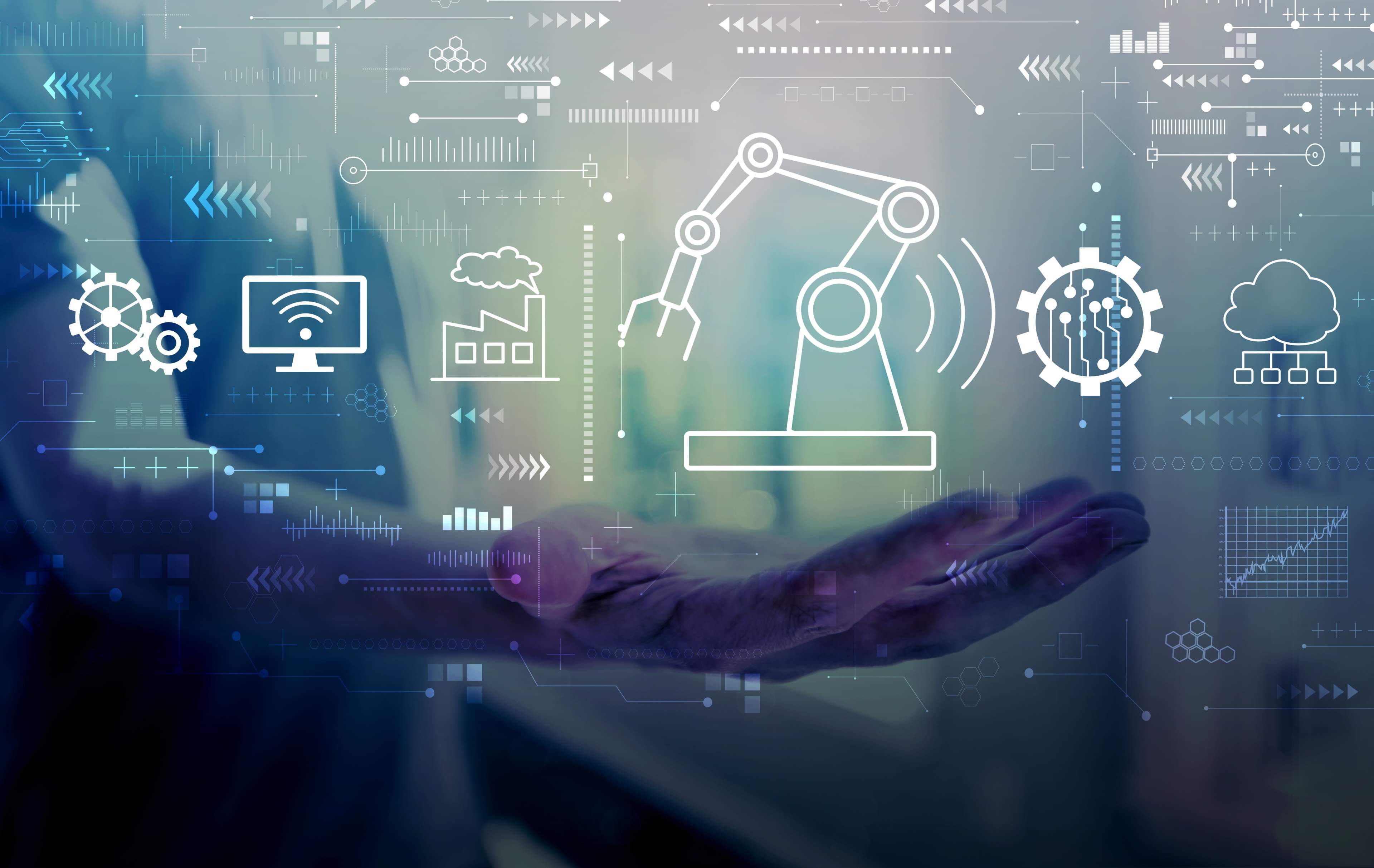In the world of Industry 4.0, IT solutions for manufacturing are modernizing everything from worker training to batch production to equipment maintenance. The manufacturing companies emerging as leaders in this new era are the ones finding ways to use these technologies to reduce operating costs, improve operational efficiency, and increase market competitiveness.
But which technologies are best to streamline your operations and increase productivity? This piece offers an overview of 10 IT solutions powering the manufacturing industry. Read on for an overview of what each can do, which situations each tends to work best in, and how you can update your IT services to accommodate each.
1. Artificial intelligence (AI)
Artificial intelligence (AI) has been around for a while, though generative AI has exploded onto the scene more recently. Broadly speaking, AI involves training large data sets to be able to predict outcomes based on past – and ongoing – events.
The AI in your phone, for example, can predict which word you’ll likely type next in a text message. As you text more and more, it continues to “learn” (via machine learning) to predict your messages more and more accurately.
Applications: In a manufacturing facility, AI might be used for predictive maintenance, quality control, demand forecasting, and more.
Case study: An automobile manufacturing facility relies on several complex, aging pieces of equipment to produce key components. These pieces occasionally break down, forcing a halt in production.
The facility could build software powered by artificial intelligence to predict when each piece is likely to break down (e.g., after a certain number of hours of use, when certain environmental conditions are present, etc.), allowing the manufacturer to schedule maintenance to prevent unplanned downtime.
2. Augmented reality (AR) and virtual reality (VR)
Augmented reality (AR) involves superimposing digital images or projections onto real-world settings, while virtual reality (VR) involves experiencing a fully immersive digital world. While both may make use of headsets to create their experiences, VR always requires a headset or other specialized equipment, while AR may be available through handheld technology (think: filters on social media).
Applications: AR and VR can be helpful for manufacturers in several situations, including…
Training workers: Manufacturers can create realistic virtual settings that closely mimic real-world settings to train workers on high-risk tasks like crane operation. VR devices that offer haptic feedback and high-quality images can create a realistic experience that lets workers learn in an environment where mistakes aren’t dangerous.
Performing maintenance: AR devices can enable less-experienced technicians to perform more complex repairs by projecting instructions and visuals over the equipment in need of maintenance. Another possibility would be to have a remote worker (say, a retiree who now works part time) guide an in-person worker through a repair they have less experience with via AR glasses.
Designing new products: AR and VR mockups of new products are far more realistic than other types of renderings. When testing new products with end users, AR and VR can create more realistic user reactions and therefore give manufacturers a better sense of what works and what doesn’t.
Case study: A manufacturer of business technology deployed an AR-based solution to field service technicians to speed up repair processes. It worked because more experienced technicians were able to provide real-time, AR-powered guidance via mobile devices to multiple field reps. This improved first-time fix rates by two-thirds and boosted efficiency by 20 percent.
3. Blockchain Technology
The blockchain is a decentralized, immutable digital ledger that can be used to track a variety of things with greater transparency and security than traditional technologies. Cryptocurrencies are famously built on blockchain technology, but they’re not the only application.
Applications: Manufacturers can use blockchains to improve the security and transparency of supply chain verification, quality assurance, and contract management.
Case study: A power tool manufacturer sets up a blockchain to track the provenance of its component parts, which come from around the world. Because the data is immutable, no supplier can change it in bad faith; because it is decentralized, no one participant has full control.
The manufacturer now doesn’t have to manage paper forms or spend as much time evaluating sources and testing components, which saves time and money.
4. Cloud solutions
Today, cloud computing is a key part of IT infrastructure around the world. But many manufacturers still rely on on-premise servers to host their data and software. Cloud computing (or “moving to the cloud”) can offer greater flexibility and scalability. In some cases, cloud instances may also save manufacturers money on their total information technology spend.
Applications: Store data and host apps in the cloud so that they’re accessible from anywhere. Set up cloud-based servers to give yourself the ability to scale up computational power for analytics as needed – and scale down during less computation-intensive periods.
Case study: Environmental monitoring solutions manufacturer Dickson shifted its operations to the cloud and developed new environmental monitoring devices with IoT-connected sensors. It also developed a cloud-based app that lets users view the status of their factories, warehouses, and other critical spaces from any device at any time.
5. Cybersecurity
Cyberattacks are a reality for every industry today. If you have digital information, there's probably somewhere out there interested in stealing it. And as more and more of the manufacturing sector relies on digital data (think: Internet of Things, web-based apps, and smart devices), more and more is susceptible to cyberattacks.
That’s why it’s so important for manufacturing companies to have robust cybersecurity measures in place, from data governance standards to third-party security services.
Applications: Protecting intellectual property, securing IoT configurations, ensuring data integrity, etc.
Case study: A medical device manufacturer produces equipment that captures patient vital signs during hospital stays and transmits them via IoT-connected sensors to EMRs. To comply with HIPAA laws, these devices must have robust data security protections in place to ensure that patient data remains secure.
6. Data science and analytics
These days, it’s more or less standard to run data-driven business operations. Data analytics and data science more generally can help extract actionable insights from complex data sets from multiple departments.
Applications: Data analytics can facilitate decision making, let manufacturers better allocate resources, forecast trends, and more.
Case study: Building pretty much any Industry 4.0 solution (AI, digital twins, etc.) will require data analytics and data science. All of these technologies are built on a foundation of data. One example: a dashboard that shows the state of environmental conditions around a facility, coded with green, yellow, and red to signal whether conditions are acceptable or not. It’s data analysis that compares things like temperature and humidity readings to acceptable ranges and then translates those comparisons to easy-to-read colors.
7. Digital twins
A digital twin is a digital replica of a physical object – like the dot on the screen of a map application as you move through physical streets.
Applications: Manufacturing organizations can use digital twins to simulate an entire production line, to test new configurations, and to identify changes that will lead to the optimization of various manufacturing processes.
Case study: As part of its larger digital transformation, a railway car servicing company wanted to identify business processes it could streamline via digital twins. The company found that it could create a digital twin of its entire railyard, then use that digital model to test various car configurations for maximum efficiency. This led to significant time and energy savings, as the former method involved moving physical objects on a whiteboard.
8. Image analysis
Image analysis involves advanced image processing techniques to identify various characteristics of real-world objects and guide the actions of either robots or human workers.
Applications: Image analysis can be useful in defect detection, quality inspection, and standards compliance in manufacturing settings.
Case study: A toy manufacturer equipped human QA workers with smart glasses running an image analysis program to improve defect detection during the QA process. The software served as a safeguard against the workers’ fatigue, distraction, and human error. The images gathered during workers’ shifts were added to the software’s training set to make it ever more accurate.
9. Internet of Things (IoT)
When physical objects connect to the internet, it’s called the Internet of Things (IoT). In manufacturing businesses, internet-connected sensors are often attached to objects and equipment so they can share location data (for example) with a cloud-based application.
At scale, IoT can be used to create a “smart factory” that streamlines workflows, reduces downtime, and makes various aspects of work visible via digital dashboards.
Applications: Monitoring equipment or inventory in real time, managing the supply chain, improving safety protocols, monitoring environmental conditions, etc.
Case study: A vaccine manufacturer can attach IoT-connected sensors to refrigeration equipment that stores various vaccine components to ensure that the equipment stays at safe operating temperatures and to identify unsafe fluctuations early enough to correct them and preserve vaccine doses or components.
10. Robotics and automation
Robotics and automation have been part of manufacturing operations for decades. Today, they’re capable of more and more within the industry. One promising use case is onshoring manufacturing work that was moved overseas years ago.
Many manufacturers are getting fewer applicants for front-line work but have plenty of workers for other roles. Robots can fill the gaps and empower manufacturers to build efficient, productive facilities in the United States.
And today’s autonomous robots are often capable of doing more than one task, which makes them flexible and adaptable to changing work conditions.
Applications: Automating assembly lines, packaging goods, handling hazardous materials, completing dull or repetitive tasks, etc.
Case study: A nuclear power plant in New England deployed automated robots to remove hazardous waste when certain thresholds are reached to reduce the risk to human workers.
The future of manufacturing IT solutions starts with data
Every technology in this list relies on data. The manufacturers that lead in the coming decades will be the ones that recognize their data as a valuable output the organization creates. They’ll take pains to organize it, apply governance policies, and use it as a source of fuel for the technologies that can propel them ahead of their competitors.
If you’re not sure whether your organization’s data is up to the requirements of Industry 4.0 technology, set up a Data Maturity Accelerator to get a sense of where you are and how you can move forward.




